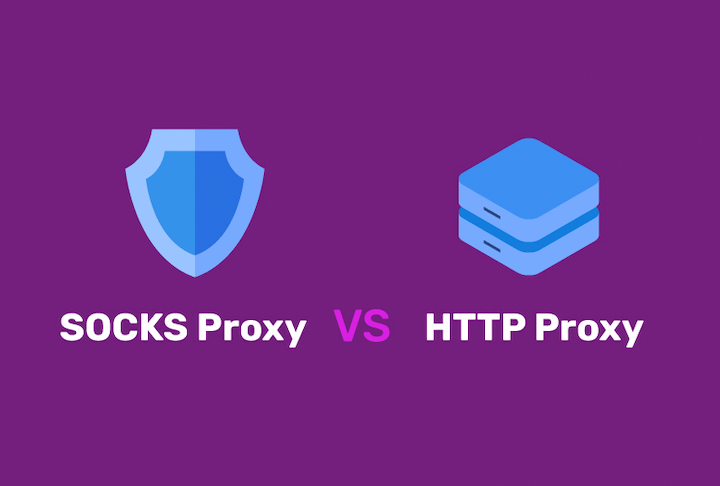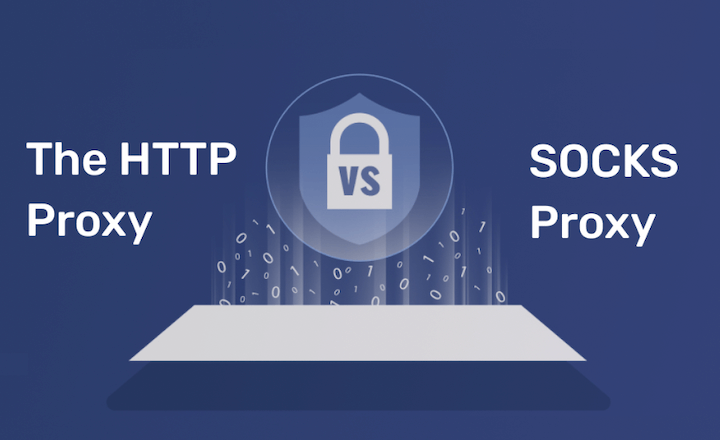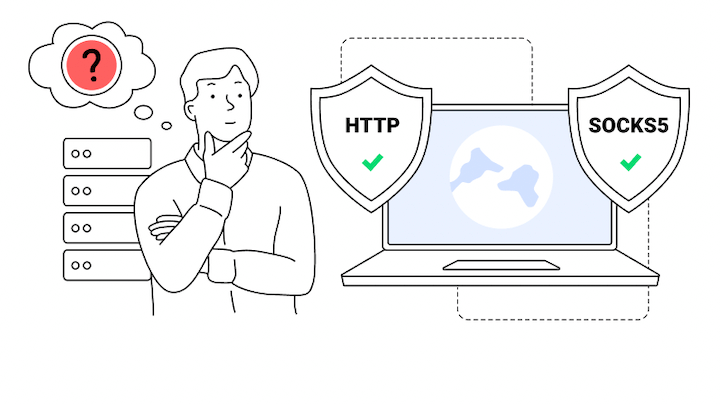HTTP vs. SOCKS: A Detailed Comparison of Proxy Protocols

In today’s vast world of internet technology, proxies have become a necessity for many individuals and businesses. These servers act as mediators between a client and a server, providing a range of advantages, including enhanced security, privacy, and access to geo-restricted content. But HTTP and SOCKS are the most commonly used among the various proxy protocols available. In this article, we seek to provide an in-depth comparison of these two protocols, aiming to shed light on their workings, strengths, and weaknesses.
Understanding Proxy Protocols
Before diving deeper into HTTP and SOCKS proxy protocols, we should clarify what a protocol is in computer networks. Essentially, a protocol is a set of standardized rules dictating how data is transmitted over a network. These rules define how data should be formatted, compressed, sent, and received, thereby ensuring that devices connected to the same network can communicate effectively.
Protocols come in many shapes and sizes, each designed to serve specific functionality and use cases. For instance, the Transmission Control Protocol (TCP) ensures the reliable delivery of a stream of bytes from one device to another on the same network. On the other hand, the Internet Protocol (IP) is responsible for addressing and routing each data packet to its destination. A proxy protocol, like HTTP or SOCKS, defines the rules for how data requests and responses are handled between a client and a proxy server.
Considering their crucial roles and applications, we can hardly overstate the importance of choosing a suitable protocol for specific needs. The protocol choice directly affects a proxy server’s performance, security, and compatibility. For example, an HTTP proxy might be your best bet if you’re primarily handling HTTP traffic, as it is specifically designed for that type of traffic. On the other hand, a SOCKS proxy would be more suitable if you need a service that can handle all kinds of internet traffic. Therefore, understanding the strengths and weaknesses of each protocol is critical to optimizing your network’s efficiency and security.
Detailed Overview of HTTP Proxies

History and Development
These services have been a part of the web’s infrastructure since the early 1990s. They were primarily developed to interpret and forward HTTP requests — the most common protocol for transferring web data. Over time, they have evolved and improved, incorporating more advanced features like caching and header manipulation.
Deep Dive into HTTP Proxy Functions
Communication Model
This proxy type is an intermediary between a client (often a web browser) and a server. When the client requests to access a webpage, it first sends the request to the proxy, which then forwards it to the intended server. Once the server responds, the proxy service receives the response, possibly modifies it, and then sends it back to the client.
Caching Capabilities
One of the distinguishing features of these proxies is their ability to cache data. It means that they can store responses from servers and, if the same content is requested again, deliver it directly from the cache without contacting the server again. This functionality can significantly speed up browsing for frequently visited websites.
Protocol-Specific Features
This proxy type is explicitly designed for HTTP traffic. It means they can interpret the data they relay, allowing them to provide additional functionality like modifying request or response headers for added privacy or security. Additionally, they can block certain types of content or redirect requests to different servers.
Understanding Advantages
These services offer several advantages. Their ability to interpret and manipulate HTTP traffic allows them to provide a high level of control over the data that passes through them. They can provide enhanced privacy and security, improve web browsing speed through caching, and offer the ability to block or redirect specific requests.
Understanding Disadvantages and Limitations
However, these services also have their drawbacks. Since they are designed to handle HTTP traffic, one cannot use them for other types of internet traffic, such as FTP or torrents. Additionally, they can be susceptible to attacks like IP spoofing if not correctly configured.
Detailed Overview of SOCKS Proxies

History and Development
SOCKS, which stands for Socket Secure, is a type of proxy protocol that has been in use since the early 1990s. It was developed as a more versatile and secure alternative to other proxy types available at the time. The protocol has two main versions: SOCKS4 and the more advanced and commonly used SOCKS5.
Deep Dive into SOCKS Proxy Functions
Communication Model
Like an HTTP proxy, a SOCKS proxy also acts as an intermediary between the client and the server. However, unlike the former, these are not limited to HTTP traffic. They work at a lower level, establishing a TCP (Transmission Control Protocol) or UDP (User Datagram Protocol) connection with the server on behalf of the client. It means that any data sent from the client is forwarded directly to the server without being interpreted by the proxy.
Protocol-Specific Features
SOCKS proxies, particularly SOCKS5, offer some advanced features. For example, SOCKS5 supports both TCP and UDP, which makes it versatile enough to handle different types of traffic, including web, mail, FTP, and torrents. SOCKS5 also supports various authentication methods, enhancing the security of the connections it handles.
Level of Versatility
SOCKS services are highly versatile. They can handle any traffic or protocol over a network connection, making them ideal for many applications. It includes everything from web browsing and email to VoIP calls and peer-to-peer file sharing.
Understanding Advantages
These services offer several key advantages. Their multi-functionality allows them to handle various traffic types, making them suitable for multiple applications. They operate at a lower level, meaning they don’t interpret the data they relay, which can enhance security as they’re less likely to expose sensitive data. SOCKS5 proxies also support a variety of authentication methods, further improving safety.
Understanding Disadvantages and Limitations
Despite their strengths, these proxies also have some drawbacks. Because they don’t interpret the data they relay, they lack some advanced features that HTTP proxies offer, such as content filtering or data caching. It can make them less efficient for specific use cases like web browsing. Additionally, their setup can be more complex and may provide slower speeds due to the absence of traffic-specific optimizations.
Comparison Between HTTP and SOCKS Proxies

Similarities Between HTTP and SOCKS Proxies
Both proxy types serve as intermediaries between the client and the server, accepting and returning data on the client’s behalf. They both improve anonymity by masking the client’s IP address, and they can both handle HTTP traffic. However, despite these major similarities, you should also consider their differences.
Critical Differences Between the Two Proxy Types
- Protocol-Specific Features Comparison
HTTP proxies can only handle HTTP traffic, which allows them to interpret and manipulate this data. It enables features like caching, content filtering, and header modification. Conversely, SOCKS do not interpret the data they relay. But they can handle a broader range of protocols, including HTTP, FTP, SMTP, and more. - Performance and Speed Comparison
Due to their caching capabilities, HTTP proxies often provide faster speeds. However, due to their versatility, SOCKS proxies may be more reliable for handling mixed or non-HTTP traffic. - Security Comparison
HTTP proxies can provide a certain level of security through features like header manipulation, but because they interpret the data they handle, they can potentially expose sensitive information. SOCKS do not interpret data and are generally considered more secure. Furthermore, SOCKS5 supports various authentication methods, enhancing its security. - Versatility and Compatibility Comparison
SOCKS proxies are highly versatile and compatible with all types of internet traffic and applications, making them ideal for varied usage. HTTP proxies, while less versatile, offer traffic-specific optimization for web browsing.
Use-Cases for Both Protocols
When to Use HTTP Proxy
These services are ideal when handling strictly HTTP traffic, especially for web browsing. They offer faster access to frequently visited websites due to their caching capabilities. You can also use them for data scraping or when specific manipulations of headers are required.
When to Use SOCKS Proxy
SOCKS services shine in scenarios requiring handling various traffic types or protocols beyond HTTP. They are more secure, making them ideal for activities that demand more anonymity and privacy, such as P2P file sharing or circumventing geo-restrictions. SOCKS proxies are also suitable for tasks that involve FTP, SMTP, or other non-HTTP protocols.
Choosing Between HTTP and SOCKS

Considerations When Selecting a Proxy Protocol
You must consider several factors when selecting between the two proxy types. The type of traffic you’ll be dealing with is crucial:
- An HTTP proxy may be the optimal choice if it’s exclusively HTTP.
- If it involves various protocols, SOCKS may be a better fit.
The level of security required is another important factor, as SOCKS proxies generally offer superior protection due to their method of handling data.
Role of Use-Case, Security Needs, and Performance Demands
Your specific use case plays a significant role in this decision. If you require content filtering or caching or want to modify headers, an HTTP proxy is your only choice. Conversely, SOCKS would be a better fit if your use case involves diverse types of traffic or requires high security or anonymity.
Your performance demands also matter. HTTP proxies can provide faster speeds due to their ability to cache, whereas SOCKS services, which lack such optimization, might be slower. However, the latter proxies could offer more reliable mixed or non-HTTP traffic performance.
Guidance on Making the Right Choice for Different Scenarios
Finally, remember that your choice should depend on your specific needs and circumstances.
- If you primarily browse or scrape website data, an HTTP proxy will serve you well with its traffic-specific optimization.
- If you’re involved in P2P file sharing, streaming services, or anything that requires handling various protocols, a SOCKS proxy would be a better choice.
- For situations that require enhanced security and anonymity, SOCKS, particularly SOCKS5 with its authentication capabilities, would be ideal.
- If your usage requires blocking or filtering certain web content, for instance, URL or keyword filtering, the interpretive capabilities of HTTP proxies would be advantageous.
Remember, no one-size-fits-all solution exists in the realm of proxy protocols. Therefore, understanding your needs and the strengths and weaknesses of each protocol is vital for making the right decision.
Bottomline
In conclusion, both proxy protocols offer unique strengths and weaknesses. HTTP proxies offer speed and advanced features for HTTP traffic, while SOCKS proxies provide versatility and a higher level of security. Understanding the differences between these two protocols is vital in making an informed decision that best suits your needs.
As the technology landscape evolves, so do the demands on proxy protocols. Staying informed and adaptable is crucial in navigating the ever-changing world of internet technology.
